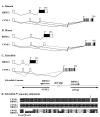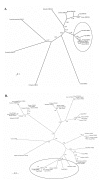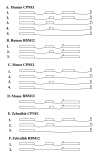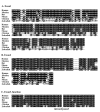Promoter-sharing by different genes in human genome--CPNE1 and RBM12 gene pair as an example
- PMID: 18831769
- PMCID: PMC2568002
- DOI: 10.1186/1471-2164-9-456
Promoter-sharing by different genes in human genome--CPNE1 and RBM12 gene pair as an example
Abstract
Background: Regulation of gene expression plays important role in cellular functions. Co-regulation of different genes may indicate functional connection or even physical interaction between gene products. Thus analysis on genomic structures that may affect gene expression regulation could shed light on the functions of genes.
Results: In a whole genome analysis of alternative splicing events, we found that two distinct genes, copine I (CPNE1) and RNA binding motif protein 12 (RBM12), share the most 5' exons and therefore the promoter region in human. Further analysis identified many gene pairs in human genome that share the same promoters and 5' exons but have totally different coding sequences. Analysis of genomic and expressed sequences, either cDNAs or expressed sequence tags (ESTs) for CPNE1 and RBM12, confirmed the conservation of this phenomenon during evolutionary courses. The co-expression of the two genes initiated from the same promoter is confirmed by Reverse Transcription-Polymerase Chain Reaction (RT-PCR) in different tissues in both human and mouse. High degrees of sequence conservation among multiple species in the 5'UTR region common to CPNE1 and RBM12 were also identified.
Conclusion: Promoter and 5'UTR sharing between CPNE1 and RBM12 is observed in human, mouse and zebrafish. Conservation of this genomic structure in evolutionary courses indicates potential functional interaction between the two genes. More than 20 other gene pairs in human genome were found to have the similar genomic structure in a genome-wide analysis, and it may represent a unique pattern of genomic arrangement that may affect expression regulation of the corresponding genes.
Figures





Similar articles
-
Alternative splicing in the murine and human FXR1 genes.Genomics. 1999 Jul 15;59(2):193-202. doi: 10.1006/geno.1999.5868. Genomics. 1999. PMID: 10409431
-
Genomic organization and structure of the 5'-flanking region of the TEX101 gene: alternative promoter usage and splicing generate transcript variants with distinct 5'-untranslated region.Mol Reprod Dev. 2007 Feb;74(2):154-62. doi: 10.1002/mrd.20584. Mol Reprod Dev. 2007. PMID: 16941676
-
Characterization and expression analyses of anti-apoptotic Bcl-2-like genes NR-13, Mcl-1, Bcl-X1, and Bcl-X2 in Atlantic cod (Gadus morhua).Mol Immunol. 2010 Jan;47(4):763-84. doi: 10.1016/j.molimm.2009.10.011. Epub 2009 Nov 17. Mol Immunol. 2010. PMID: 19923001
-
Cluster analysis and promoter modelling as bioinformatics tools for the identification of target genes from expression array data.Pharmacogenomics. 2001 Feb;2(1):25-36. doi: 10.1517/14622416.2.1.25. Pharmacogenomics. 2001. PMID: 11258194 Review.
-
The complexity of the mammalian transcriptome.J Physiol. 2006 Sep 1;575(Pt 2):321-32. doi: 10.1113/jphysiol.2006.115568. Epub 2006 Jul 20. J Physiol. 2006. PMID: 16857706 Free PMC article. Review.
Cited by
-
RNAP II processivity is a limiting step for HIV-1 transcription independent of orientation to and activity of endogenous neighboring promoters.Virology. 2015 Dec;486:7-14. doi: 10.1016/j.virol.2015.08.027. Epub 2015 Sep 14. Virology. 2015. PMID: 26379089 Free PMC article.
-
An Overview on the Complexity of OCT4: at the Level of DNA, RNA and Protein.Stem Cell Rev Rep. 2021 Aug;17(4):1121-1136. doi: 10.1007/s12015-020-10098-3. Epub 2021 Jan 2. Stem Cell Rev Rep. 2021. PMID: 33389631 Review.
-
A re-annotation pipeline for Illumina BeadArrays: improving the interpretation of gene expression data.Nucleic Acids Res. 2010 Jan;38(3):e17. doi: 10.1093/nar/gkp942. Epub 2009 Nov 18. Nucleic Acids Res. 2010. PMID: 19923232 Free PMC article.
-
CPNE1 Enhances Colorectal Cancer Cell Growth, Glycolysis, and Drug Resistance Through Regulating the AKT-GLUT1/HK2 Pathway.Onco Targets Ther. 2021 Jan 27;14:699-710. doi: 10.2147/OTT.S284211. eCollection 2021. Onco Targets Ther. 2021. PMID: 33536762 Free PMC article.
-
Transcription of angiogenin and ribonuclease 4 is regulated by RNA polymerase III elements and a CCCTC binding factor (CTCF)-dependent intragenic chromatin loop.J Biol Chem. 2014 May 2;289(18):12520-34. doi: 10.1074/jbc.M114.551762. Epub 2014 Mar 21. J Biol Chem. 2014. PMID: 24659782 Free PMC article.
References
-
- Zhang W, Morris QD, Chang R, Shai O, Bakowski MA, Mitsakakis N, Mohammad N, Robinson MD, Zirngibl R, Somogyi E, Laurin N, Eftekharpour E, Sat E, Grigull J, Pan Q, Peng WT, Krogan N, Greenblatt J, Fehlings M, Kooy D van der, Aubin J, Bruneau BG, Rossant J, Blencowe BJ, Frey BJ, Hughes TR. The functional landscape of mouse gene expression. J Biol. 2004;3:21. doi: 10.1186/jbiol16. - DOI - PMC - PubMed
Publication types
MeSH terms
Substances
LinkOut - more resources
Full Text Sources
Molecular Biology Databases
Miscellaneous

